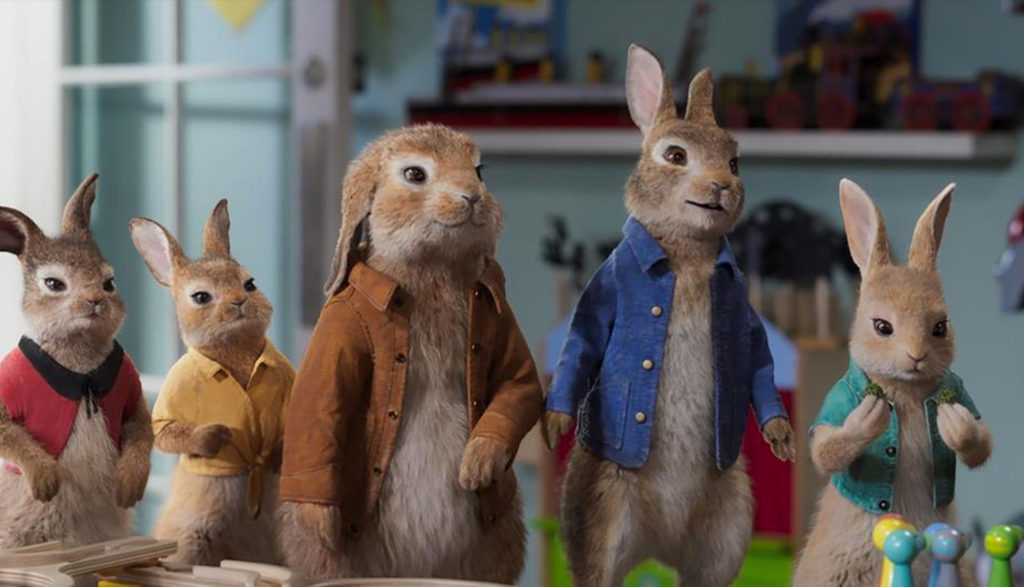
The sweet and loving Bea and her animal-wary beau Thomas are married. And they and Bea’s beloved rabbit “children”—Peter, Mopsy, Flopsy, Cottontail and Benjamin—are all living in share-the-garden harmony.
Well, kinda.
There’s still a bit of tension between Peter Rabbit and Thomas. Thomas doesn’t really trust the rascally bunny. And Peter, well, he’s pretty sure that Thomas wants to start a family of human children, and when that happens, the rabbits will be tossed out on their fluffy little tails: no garden, no Bea, no nothing!
That new family tension comes to a head when Bea is approached by a big London publisher who wants to transform her charming little children’s book (about a group of garden rabbits) into a mega-seller. Problem is, he also wants to change things up a bit and transform the Peter character in her book (and based, of course, on the real-life rascally rabbit) into a sneering villain.
Peter’s none too happy about that.
On top of those irksome things, Peter meets a fellow bunny named Barnabas while in London, and that roughed-up-rabbit invites Peter into something of a bad crowd of city critters. Bad bunny Barnabas may well have known Peter’s dad way-back-when. And he’s planning an audacious farmer’s market heist that he’s sure Peter would be perfect for.
Peter can’t help but think that maybe all this was meant to be. Maybe he is nothing more than a thief and troublemaker. And maybe he could find a place with his dad’s old friend before Thomas officially kicks him out anyway.
You know rabbits. Sometimes they can be a lot like children. And sometimes they can be oh, so silly.
In a very self-aware, meta turn, this film plays with the idea of updating Bea’s Peter Rabbit story—transforming the rabbits into commercialized moneymakers that don’t fit the author’s initial sweet purpose. But it also uses that idea (and some other elements) to encourage young viewers to find their place and purpose in life and to stay true to the earnest goals that drive you.
On top of that, Peter’s adventure points to the fact that a family’s love can be transformative and beneficial. And that family, it tells us, isn’t just one thing. It can take many different forms and shapes, and still be a wonderful and loving group.
This pic also winkingly points to the fact that we can all make positive changes in our lives. For example, Peter tells a fox character that he doesn’t have to go chasing the other animals since they can all share the garden freely. And the fox decides to try running “without a terrified animal in front of you.” He eventually becomes strong and athletic.
None.
After Peter meets Barnabas, he goes to Benjamin Rabbit to tell him he met someone. Benjamin thinks it’s a girl rabbit and gets excited about Peter’s romantic possibilities. Peter says it’s a thief named Barnabas. And Benjamin replies, “You do not have my permission to kiss a thief!”
There are nods to the fact that marriage can lead to having babies. A mouse character emphasizes that by displaying his 15 kids’ pictures after his first month of marriage.
Some viewers may interpret a certain pig in the movie as a “gay” character. But other than embodying some cliched stereotypes, nothing in the film suggests the pig’s actual romantic preferences.
At one point, Barnabas asks Peter how he’s so good at some of the mischief-causing things he does and Peter replies that he’s “terrible at foreign languages, great at cartoon violence.” And we see plenty of that cartoony human and CGI critter pummeling here.
Thomas gets thumped around quite a bit between rolling violently down a hill and other pummeling activities. And a woman is comically bashed by a refrigerator door, sprayed with champagne and slams into the floor and other solid surfaces while trying to catch Peter.
Peter also imagines a wedding rumble between humans and animals. In turn, Peter and other animals are swatted by broom-wielding humans. A pair of rambunctious children play roughly with their pets. CGI animals of all stripes are tossed about in the course of chase scenes and tumbling action. It’s all played for giggles.
One particular scene appears to be turning ugly, though, when Barnabas and his animal crew tie up a nosey pig and tell Peter to take care of him. Peter balks at the idea of purposely hurting someone and says nervously, “I don’t do this.” And then the other animals and the pig all laugh and say it was a joke.
Near the end of the film, captured animals are sold to human owners and, in some cases, it appears that the animals (a pig, a rabbit and a frog) are going to be used to make food stuffs and used for school science lab dissection. But Peter, Bea and Thomas rescue them all in the nick of time.
None.
Sugar becomes something of an addictive substance for Cottontail Rabbit when she first gets a taste of a jellybean and then can’t stuff enough of the sweet delights into her mouth. She becomes obsessed with the colorful beans and later offers one to a baby, saying, “Try this jellybean. It’ll change your life.”
Peter and Barnabas also find a bottle of champagne in someone’s refrigerator and spray a woman in the face with the bubbly brew.
There’s a bit of winking toilet humor mixed in throughout the script. One cat character, for example, reports that he’s “freezin’ my catnip off” when coming inside from the cold. In another instance, a rabbit decides to shake up her ordered life and change her name to “lavatory” … until she finds out what it means. We hear some belching giggles and the like.
A woman tells her kids, “They’re animals. They don’t have feelings!” Peter and his animal friends are also pulled in to stealing things. And someone not only justifies theft and bad behavior but eventually betrays those who trusted him. (But there’s a definite comeuppance for all those bad behaviors.)
Movies, like rabbits, can sometimes feel a lot like children, too.
There are times when they are bad. And when they’re naughty, you can’t help but want to give them a stern look, maybe shake a finger, and say NO! You might even feel it necessary to calmly explain why the things they did were very, very bad or harmful.
On the other hand, when movies, and rabbits, are good—when they’re sweet, and kind and funny and, perhaps, don’t do anything out of the ordinary but be their natural little lovable selves—you can’t help but smile and admire them.
All right, maybe that’s pushing the analogy too far. But you get the point.
Peter Rabbit 2 is a sweet little pic about a group of childlike and sometimes mischievous rabbits that’s a very natural delight. The blending of live action and CGI is seamless and appealing. The sequel adventure frolics fearlessly to and fro and actually makes for a much better story than the first film. And it comes packing nice little lessons about loving and relying on family, as well as some smile-worthy meta-ruminations on finding your place and purpose in life.
Purists may still lament that Beatrix Potter’s gentle countryside rabbits aren’t really represented here. But kids won’t care. And frankly, I can’t imagine most adults will either. They’ll be too busy smiling.


After spending more than two decades touring, directing, writing and producing for Christian theater and radio (most recently for Adventures in Odyssey, which he still contributes to), Bob joined the Plugged In staff to help us focus more heavily on video games. He is also one of our primary movie reviewers.